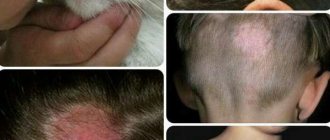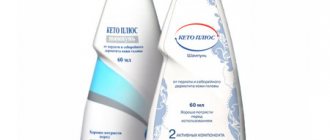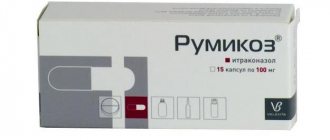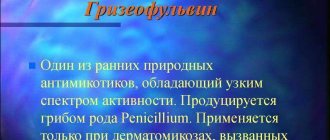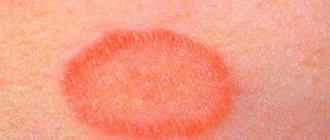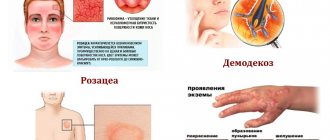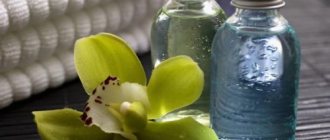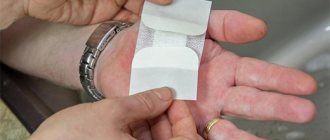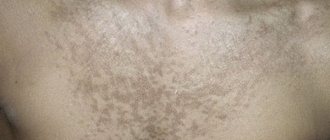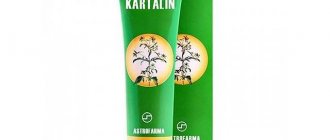Dermatologists have combined a group of dermatological diseases into one type - lichen. Therefore, one cannot judge lichen as a specific skin disease.
Today there are several types of it:
- red flat;
- shearer;
- pink;
- encircling;
- pityriasis (colored);
- psoriasis;
- eczema.
Each of these types has its own etiology of development and requires individual treatment therapy, which should be prescribed only by the treating doctor.
It consists in using:
- anti-inflammatory;
- antifungal;
- antiallergic;
- and antiviral drugs for external and oral use.
External remedies prescribed for lichen should be used with great caution, because not all types of it can be treated with ointments, gels, and creams. So, for example, pityriasis rosea does not require any therapy. Its main property is its spontaneous disappearance after one and a half to two months of the active phase.
Treatment of deprivation with ointments
Today in pharmacies there is a very large assortment of ointments, creams, and gels for lichen, but without knowing their main characteristics, it is very difficult to make a choice. Using them on your own can lead to complications. So, for example, there are cases of treating viral lichen with antifungal drugs, which is extremely inappropriate.
Each tube of ointment is designed to combat a specific type of infection, and if you want to inhibit the process of spreading lichen throughout the body, you should carefully study the instructions for use, and also listen to the recommendations of doctors.
Treating lichen planus
This type of infectious dermatosis is caused by a violation of metabolic processes in the body, reminiscent of an allergic reaction. During the period of lichen planus, the skin is very itchy, the resulting papules unite into small and large islands. Therapeutic therapy is aimed primarily at relieving itching, swelling and inhibiting inflammatory processes in the upper layers of the skin.
Ointments such as:
- "Triamcinolone" - the maximum permissible treatment period does not exceed twenty-five days, applied to the affected areas of the skin in a thin layer two to three times a day;
- “Celestoderm” - therapy with this drug lasts about two weeks, is suitable for the treatment of lichen in adults and children, applied to lichen spots one to three times a day;
- “Flumetasone” - this cream is used to treat lichen for two weeks; the affected surface of the skin is smeared with it one to three times a day;
- “Advantan” - treatment with this cream lasts twelve weeks in adults, four weeks in children, applied to the lichen islands once a day;
- Hydrocortisone 1% ointment - the period of treatment for lichen with this medicine can last from six to twenty days, suitable for adults and children, applied to the affected areas of the skin two to three times a day;
- Prednisolone ointment 0.5% - lichen is treated with this remedy in adults for eight to fourteen days, in children - up to seven days, applied to the skin for two to three days.
The above ointments belong to the group of glucocorticosteroids - hormone-containing drugs. They promote artificial immunosuppression, which is necessary for allergic reactions to any irritant - internal or external. The expected effect from their use is sustainable. However, these drugs are prescribed when there is no alternative because they are addictive.
Treatment of ringworm, pityriasis versicolor
The causative agents of ringworm and pityriasis versicolor are fungal infections that mainly affect the scalp. Therapeutic therapy for these types of disease is aimed at suppressing the fungus, therefore, patients are prescribed an antifungal ointment for lichen, which not only decomposes it, but also relieves inflammation on the skin, eliminates itching and dry skin, and kills microbes.
Particularly effective against fungi that cause inflamed skin changes are ointments that contain:
Exoderil
Particularly effective against fungal etiology is Exoderil cream with the active antifungal substance naftifine. Apply to the skin once a day, therapy lasts about one month.
Clotrimazole
Also in demand today is the antifungal ointment Clotrimazole. Treatment with this drug lasts from one week to two months. It is applied four times a day to inflamed spots.
Zinc ointment
Ringworm can be quickly treated with the use of “Zinc Ointment” based on Vaseline. It has an anti-inflammatory, drying effect on the skin, eliminates the risk of developing purulent foci, and promotes rapid restoration of the skin. It is applied to lichen spots five times a day. The treatment period lasts until the skin is completely healed.
Sulfuric ointment
For ringworm, “Sulfur ointment” helps - an antiseptic, anti-inflammatory agent. Rub into the skin twice a day for five days. Highly effective in combination with antibiotics.
“Salicylic ointment” also does not give up its position in relation to pityriasis versicolor. This drug is not applied to moles, mucous membranes and warts. All smeared areas are covered with bandages or medical plaster, which must be changed once every two to three days. Therapy lasts from one to three weeks.
Treatment of ringworm, pityriasis versicolor
The causative agents of ringworm and pityriasis versicolor are fungal infections that mainly affect the scalp.
Therapeutic therapy for these types of disease is aimed at suppressing the fungus, therefore, patients are prescribed an antifungal ointment for lichen, which not only decomposes it, but also relieves inflammation on the skin, eliminates itching and dry skin, and kills microbes. Particularly effective against fungi that cause inflamed skin changes are ointments that contain:
- terbinafine;
- mycoseptin;
- ketoconazole;
- clotrimazole;
- Lamisil.
Exoderil
Particularly effective against fungal etiology is Exoderil cream with the active antifungal substance naftifine. Apply to the skin once a day, therapy lasts about one month.
Clotrimazole
Also in demand today is the antifungal ointment Clotrimazole. Treatment with this drug lasts from one week to two months. It is applied four times a day to inflamed spots.
Zinc ointment
Ringworm can be quickly treated with the use of “Zinc Ointment” based on Vaseline. It has an anti-inflammatory, drying effect on the skin, eliminates the risk of developing purulent foci, and promotes rapid restoration of the skin. It is applied to lichen spots five times a day. The treatment period lasts until the skin is completely healed.
Sulfuric ointment
For ringworm, “Sulfur ointment” helps - an antiseptic, anti-inflammatory agent. Rub into the skin twice a day for five days. Highly effective in combination with antibiotics.
Salicylic ointment
“Salicylic ointment” also does not give up its position in relation to pityriasis versicolor. This drug is not applied to moles, mucous membranes and warts. All smeared areas are covered with bandages or medical plaster, which must be changed once every two to three days. Therapy lasts from one to three weeks.
External therapy for herpes zoster
This type of shingles is caused by the varicella zoster virus. The appearance of a profuse skin rash along the nerve trunks is a secondary sign of a living virus in the body of a person who has had chickenpox. Thus, in this case, an ointment for skin ringworm with antiviral properties is needed. These are the drugs:
- “Herperax” is an immunostimulant, relieves pain, reduces foci of inflammation, the duration of treatment for ringworm is from five to ten days, applied to the affected areas of the skin four to six times a day;
- “Panavir gel” - destroys viruses at the cellular level, stimulates the immune system, relieves itching, anesthetizes and relieves inflammation, treatment lasts from two to five days, applied to the skin two to five times a day;
- “Acyclovir” (“Zovirax”) – the cream is applied to the skin for a week five times a day, relieves pain, reduces the risk of developing secondary infections, and accelerates the healing process of the skin;
- "Panthenol" - a healing drug is applied to the skin up to three times a day, treatment lasts about two weeks.
How to treat lichen in a child at home?
The affected areas are treated with salicylic alcohol 2–3% and iodine tincture. Sulfur-salicylic or sulfur-tar ointments are applied with great care (allowed from 2 years of age). More expensive external agents such as Lamisil or Ketoconazole are also used to treat lichen. Most of these drugs cannot be used if the child is under 2 years old.
Antifungal ointments for the treatment of lichen in children:
- Cream "Clotrimazole". The active substance of the same name is active against dermatophytes and pathogens of lichen versicolor. The product is applied two or three times a day, gently rubbed into the affected area.
- Ointment "Mikoseptin". The active ingredients are undecylenic acid and its zinc salt. The product is used for lichen caused by trichophytes and dermatophytes. The ointment is applied to clean, dry skin twice a day for 10–14 days.
- Terbinafine cream or ointment. The active substance of the same name affects different groups of fungi, which are the causative agents of lichen on the skin, mycoses of nails and hair. The product is suitable for children over 2 years old. Apply once or twice a day to cleanly washed and well-dried skin of the body or head.
- Ridoxol ointment. Treatment of lichen in a child can be carried out with an ointment based on the active substance triiodoresorcinol.
In Russia, during clinical trials of ridoxol ointment 1%, researchers and doctors observed a pronounced therapeutic effect in 14 children who suffered from lichen (skin microsporia). Apply the product to the affected areas twice a day for 14 days. In the control groups, griseofulvin was prescribed orally, and external treatments were carried out with iodine preparations and sulfur-tar ointment. When treated with ridoxol ointment, the itching disappeared faster, and the skin acquired a healthy appearance.
The child is prescribed medications for topical and oral administration, taking into account the severity of the disease. The doctor determines the dosage and duration of treatment taking into account the type of lichen and the patient’s health condition. Children under 12 years of age are one of the most common contraindications for the use of potent antifungal and anti-inflammatory drugs. Therefore, a dermatologist should discuss with parents the question of how to treat lichen in children and inform them about contraindications of prescribed drugs.
Treatment of psoriasis
Psoriasis is an incurable form of lichen, the cause of which is metabolic and immune disorders in the human body, vitamin deficiencies, and mental instability.
Consequently, therapy is aimed at restoring metabolic processes, taking fortified courses, like this:
- metabolic processes are affected by Akrustal cream, which relieves itching and promotes cell regeneration in the upper layers of the epidermis;
- Replenishes the lack of vitamin D in the body with Daivonex ointment;
- Antipsor gel relieves pain and relieves inflammation.
“Salicylic ointment” and “Zinc ointment” are also used for psoriasis.
Treatment of eczema
Therapy aimed at combating eczema consists of using:
- hormonal ointments;
- non-hormonal external drugs.
Hormonal agents
The group of hormonal drugs includes ointments:
- “Lokoid” - used in the treatment of eczema in adults and children, relieves inflammation, eliminates the feeling of severe itching and swelling of irritated areas of the skin, applied up to three times a day, treatment with this drug lasts two weeks;
- “Cinacort” is an antiallergic drug, relieves inflammation and has an anti-exudative effect on the skin, rubbed in twice a day, treatment duration is two weeks;
- “Soderm” – eliminates pain, itching and redness of the skin, applied to the skin no more than twice a day, the duration of treatment is adjusted by the attending physician;
- “Dermovate” is intended for the treatment of complex eczema, reduces the extent of skin lesions, relieves itching and irritation, is applied to the skin once a day, treatment with this product is performed under the supervision of a physician.
- Hydrocortisone 1% ointment.
Types of lichen
Pityriasis rosea is the mildest form of this disease. It appears in the form of small pink spots that begin to peel from the center to the edges. It can be infectious or allergic. It is transmitted very quickly, therefore, if this form is found in a child or adult, he should be immediately isolated from others. make an accurate diagnosis , so before purchasing an ointment you should consult a dermatologist.
Lichen planus is more common in adults than in children. Basically, it takes on a chronic form and is very difficult to treat. Appears as small red spots containing fluid. They are most often located on the stomach, arms, and in rare cases – on the oral mucosa. The disease is often accompanied by severe itching. The causes of its occurrence are: allergies, viruses, and in some cases neurology.
Ringworm gets its name due to the fact that lesions appear on the scalp that resemble clipped areas that are itchy and flaky. This disease can also form on the nails. It is otherwise called feline because it is transmitted through contact with animals. This type of lichen is very contagious and spreads quite quickly from person to person. The disease does not manifest itself at all for a long time, because its incubation period is very long. As a result, a large number of adults and children can become infected from communicating with a sick person.
Pityriasis versicolor appears as small pale pink spots without signs of inflammation. Warm and humid conditions favor the development of this disease.
Shingles is the most severe form of the disease and can cause serious complications. It is caused by a virus that attacks the human body when immunity decreases. Symptoms of shingles are: fever, high temperature, headache. The skin becomes covered with blisters of liquid, accompanied by painful sensations.
Types of drugs for lichen
The choice of medication depends on the type of pathology, the causes of which are different:
| Type of lichen | Pathogen/Cause |
| Pityriasis (multi-colored) | Yeast-like fungi Pityrosporum orbiculare, Pityrosporum ovale, Malassezia furfur |
| Shearer | Dermatophyte fungi Trichophyton, Microsporum |
| girdling | Varicella-zoster virus |
| Pink | Presumably an allergy, a virus. |
| Red flat | It is unclear exactly: stress, infections, allergies, metabolic disorders, genetic predisposition. |
All remedies for lichen belong to two groups:
- Local preparations: sprays, creams, suspensions, ointments, solutions.
- Oral medications: capsules, drops, tablets for internal use.
First, external medications are used; if they do not work, tablets are prescribed. Depending on the type of lichen, the following groups of drugs are used:
- antiviral;
- antifungal;
- antihistamines;
- immunomodulatory;
- bacterial antibiotics.
Vaccinations against skin pathologies are not given to people; the vaccine against lichen is used only to treat animals in order to speed up the course of the disease. It is used only in Russia; other countries have refused vaccination.
Antifungal drugs
Prescribed for the treatment of ringworm and pityriasis versicolor. Some of the drugs act on different types of parasites, others destroy a specific type of fungus. Some medications are produced both in the form of tablets for internal use and in the form of ointments for external use.
Medicines for ringworm
This type of skin infection is treated with the following medications:
- “Griseofulvin” Tablets for ringworm : stop the proliferation of fungi, the active component accumulates in the skin, nails, and hair. Dosage depends on weight. Initially, take 3 times a day, wash down with a spoon of vegetable oil. If the scraping analysis shows a negative result, then the dosage is reduced. Treatment is long-term – up to 2 months. The drug is not recommended for pregnant women and children under 2 years of age.
- “Orungal” The medicine destroys the membranes of fungal cells, accumulates in the upper layers of the skin and is removed along with keratinized particles after exfoliation. Available in the form of capsules and solution. Take 2 capsules 1 time per day. The course lasts 1 week. Not prescribed to people with liver, kidney, or heart diseases.
- "Fulcin" Antifungal antibiotic. Before treating a person's lichen with this drug, they check for an allergic reaction to the drug. The daily dose, 500 mg, is taken whole or in parts. The duration of treatment depends on the location of the lesion: from 2 weeks to 6 months, in severe cases up to a year.
- "Lamisil" Acts on different types of fungus. The active ingredient is terbinafine. The daily dose of 250 mg is taken once a day at night. The duration of therapy depends on the degree of damage and the type of fungus: from 2 weeks to 3 months. Not recommended for children weighing less than 12 kg. The medicine is also produced in the form of a cream: rubbed twice a day until recovery.
- "Thermikon" Cheaper analogue of "Lamisil"
Medicines for pityriasis versicolor
This type of skin pathology is also activated by fungi. Some drugs from the previous list are suitable for its treatment: Orungal, Lamisil, Thermikon. Other tools are also no less useful:
- "Itraconazole" Destroys many types of fungus. The daily dose is 200 mg - taken daily in one dose. Course duration is 1 week.
- "Mycozoral" The active ingredient is ketoconazole. Complex effective remedy for lichen : destroys yeast-like fungi, pathogens of microsporia and trichophytosis. Take one tablet 4 times a day, the duration of administration is determined by the doctor. The medicine is also produced in the form of an ointment: it is applied once a day. Treatment lasts up to 4 weeks.
- "Fluconazole" Available in capsules. Stops the proliferation of fungi. Take 2 capsules (300 mg) per week for 2 to 4 weeks. The medicine is contraindicated for women during pregnancy.
- "Nystatin" An antifungal agent that is prescribed for cases of infection of the skin, mucous surfaces of the mouth, and pharynx by yeast-like fungi. The course lasts 10–14 days. Take 3-4 times a day, the dosage is individual - depends on the location of the lesion. They also produce an ointment that is approved for use during pregnancy.
- "Pimafucin" The drug is destructive to many fungi. Treatment lasts a week: take a tablet 4 times a day. In the form of an ointment, this medicine for lichen is approved for pregnant, lactating women and newborn children.
The duration of treatment in each case is determined by the doctor. It is not recommended to abandon the prescribed drug immediately after the first signs of improvement.
Tablets that help with lichen
With the listed types of pathology, the causative agents are fungi of various kinds, only shingles is of a viral nature. Grisefulvin is effective against ringworm, since the active substances of the drug act on a specific pathogen. When ringworm affects a person's feet, Clotrimazole and Ketoconazole are used.
You need to take 2 tablets 3 times a day
Antihistamines will help alleviate symptoms of lichen planus and lichen rosea at home:
- Suprastin;
- Loratadine;
- Zyrtec;
- Tavegil;
- Claritin;
- Cetrin.
However, such remedies do not eliminate the cause of the disease, since not a single type of lichen is caused by an allergy. But they will help in the treatment of an infectious disease, because they cope with symptoms such as itching or flaking.
Pityriasis versicolor in humans can be treated at home with antifungal drugs, such as:
- Ketoconazole;
- Oronazole;
- Irunin;
- Candithral;
- Mycozoral.
The listed antimycotic drugs are prescribed only for prolonged course of the disease. Treatment with ointments and creams is often sufficient.
Treatment of herpes zoster
Shingles in humans is caused by the herpes zoster virus, so antifungal drugs are ineffective against this disease. The following drugs are prescribed:
- Acyclovir;
- Virolex;
- Valtrex;
- Valaciclovir.
It is important to see a doctor in the first 3 days so that treatment can begin quickly and it will go faster. Many people do not know which doctor to contact for lichen, the answer is that it depends on the cause. You should consult an infectious disease specialist, dermatologist, immunologist, or neurologist.
Therapy only speeds up recovery; over time, the body independently produces antibodies to the virus. It is also recommended to drink more fluids at home.
Antiviral drugs
Used for pink and herpes zoster. If medications are taken no later than 72 hours after the onset of the disease, you can quickly cure lichen and avoid complications.
- “Acyclovir” acts selectively only on cells infected with the virus. The course lasts 5 days: take 4 tablets every 6 hours, taking a break at night. For children, the dosage is individual, depending on body weight. Acyclovir is also available in ointment form.
- "Valtrex" Take 1000 mg 3 times a day for a week. The medicine is not recommended for people with kidney and liver diseases.
- "Valacyclovir" Take for a week: 1000 mg every 8 hours. Duration of taking the drug is 1 week. Children under 12 years of age are contraindicated; older people are advised to drink plenty of fluids.
- "Famvir" The daily dose, 750 mg, is taken immediately or in parts throughout the day. The duration of taking the medicine is 7 days. Analogues: Minaker, Famciclovir-Teva, Famacivir, Familar.
Ancillary drugs
The causes of pink and red lichen planus have not been precisely established - there are only assumptions. Some medications help to significantly alleviate a person’s condition and remove lichen .
Antihistamine tablets.
They relieve allergy symptoms if the lesions are accompanied by itching and irritation. These include:
Take the tablets before bed, in courses of 2 weeks.
Antibiotics
These drugs do not treat lichen; they are prescribed for severe cases of the disease, when ulcers form and there is a risk of infection. Broad-spectrum antibiotics are usually used; they stop the proliferation of bacteria, relieve inflammation and swelling:
The dosage and duration of therapy is determined only by the doctor. If you do not follow the specialist’s recommendations, the antibiotic will stop working and the treatment will be in vain. It is usually advised to take the medicine at a certain time.
Immunomodulators
Prescribed as an adjuvant that helps to quickly cure lichen in humans . Drugs increase the body's resistance or, conversely, smooth out the negative consequences of the immune response to the disease:
- “Polyoxidonium” is used as an immunostimulant for fungal, viral, and bacterial infections. Application: dissolve 1 tablet (12 mg) 3 times a day.
- "Cycloferon" Promotes the production of interferon, which speeds up recovery. The daily dose is 450 mg - 3 tablets taken at one time. Course – 40 tablets.
- "Delagil" The active ingredient is chloroquine. Used as an immunosuppressive anti-inflammatory drug for lichen planus in humans . Daily dose 0.4 g
- “Immunal” A remedy for strengthening the immune system based on echinacea. Take a tablet 3 times a day for at least a week. Analogs: Immunorm, Echinacea, Estifan,
- "Likopid" A new generation immunostimulant drug. Use 2 mg 2 times a day.
- "Planquenil" Anti-inflammatory, immunosuppressive drug for the treatment of lichen planus. Initially, the daily dose is 400 mg, after improvement it is reduced to 200 mg. Take in 1 or 2 doses.
Symptoms
Symptoms of lichen versicolor in humans include increased sweating. In the sun, the affected skin remains untanned. Compared to healthy areas, it looks paler.
Pityriasis versicolor affects the neck, back, chest, shoulders and forearms. Less commonly, spots cover the scalp, the surface of the thighs, and the groin area. Very rarely, the rash affects the hands, legs, ears and behind-the-ear folds, and face.
At the initial stage, healthy skin is covered with small spots of pale pink color with clear boundaries, which over time increase and merge into one lesion. The color of the spots varies from pink to brown.
After the death of the pathogenic fungus, the spots begin to peel off; after peeling off the top layer, a white spot remains.
A characteristic feature of tinea versicolor is that the spots are covered with pityriasis-like scales, peeling is accompanied by itching.
The disease often lasts for several years with periods of exacerbation and subsidence of symptoms.
Sprays
They are used only externally for different types of lichen. The active component of most of these drugs is terbinafine, which destroys dermatophytes, yeast-like fungi. First, the skin is cleaned and dried, then this anti-lichen remedy is sprayed onto the affected areas, including healthy parts of the skin. Adverse reactions most often include itching, peeling, irritation, and redness, which disappear after stopping use.
In pharmacies you can find sprays with the following names:
The dosage of the drugs is not specified exactly; most often, the anti-lichen spray is sprayed until the skin becomes damp. Usually used 2 times a day. The improvement is noticeable in the first days, but the drugs should be used until complete recovery. Not recommended for women during pregnancy, people with kidney and liver diseases.
Lichen planus - alternative treatment
Before treating lichen planus with folk methods and remedies, it is necessary to eliminate the factors that contribute to the development of the disease. Often this type of lichen accompanies diseases such as chronic gastritis, gastric and duodenal ulcers, cirrhosis of the liver, diabetes mellitus, etc. It is necessary to treat these diseases. Lichen planus often manifests itself as an allergic reaction to medications, which means it is necessary to find an adequate replacement for these drugs. Before treating oral lichen caused by traumatic factors, these factors must be removed - sharp edges of teeth should be polished, dentures should be changed, caries and periodontal disease should be treated, smoking and spicy foods should be stopped.
Treatment of oral lichen planus with sea buckthorn oil Soak a cotton swab or folded piece of gauze with sea buckthorn oil and apply an application to the affected area of the mucous membrane for 30-60 minutes. It is also advisable to use sea buckthorn oil internally - 1/2 tsp. per day on an empty stomach.
Treatment with vinegar. It is recommended to treat lichen planus with apple cider vinegar: apply undiluted apple cider vinegar to the area affected by lichen for 10 minutes 4–6 times a day. Instead of vinegar, you can use viburnum or cranberry juice
Ointment made from hops, burdock and calendula. Take 1 tbsp. l. calendula flowers, and 2 tbsp. l. hop cones and burdock roots, pour 200 g of boiling water and boil, strain. Mix 1 tbsp. l. decoction and 2 tbsp. l. Vaseline. Apply a thin layer of this ointment to the affected areas several times a day.
Herbal compress. Take 3 tbsp. l. mullein flowers, 1 tbsp. l. celandine and 1 tbsp. l. willow bark. Pour 1 liter of boiling water, leave for 1 hour. Make compresses from this decoction on the affected areas or simply wipe them several times a day.
How to treat lichen planus with beets. Grate red beets and tie them to the ringworm. When beets dry out, you need to replace them with fresh ones. Continue treatment until the lichen goes away.
Traditional treatment with water Pour lichen planus with hot water for three minutes. 2 times a day; after 3 days an improvement is noticed, and after two weeks the lichen disappears.
Treatment of deprivation with herbs. It is advisable to combine external treatment of lichen planus with herbal infusions. Here are some traditional medicine recipes for lichen ruber: 1. Mix St. John's wort, centaury, nettle, juniper, plantain, wormwood, yarrow, horsetail, and sage in equal parts. 2. Mix equal parts of penny root, clover flowers, birch buds, dandelion root, wormwood grass, and string. 3. Mix in equal parts yarrow, tansy flowers, immortelle flowers, burdock root, goldenrod herb, bearberry 4. Mix in equal parts cornflower flowers, dried grass, rose hips, rowan fruits, cinquefoil root, cinquefoil root 5. Mix in equal parts black elderberry flowers, nettle, dandelion root, birch buds, juniper berries, St. John's wort 2 tbsp. l. collection, pour 1 liter of boiling water, leave overnight in a thermos. Take the entire infusion during the day, 100-150 ml. Course – 3-4 months. After which they take a break for 10-14 days, change the collection and continue treatment. They continue to treat lichen with these remedies for at least 12 months.
Tar Mix 150 g of birch tar with 2 egg yolks and 100 g of fresh cream. Rub into affected areas twice a day.
How to treat lichen planus with calendula When treating lichen planus with folk remedies, calendula flowers for compresses and rubdowns can be used in the form of an alcohol tincture, infusion (2 tablespoons per 1 cup of boiling water) or ointment. Ointment from calendula inflorescences gives the best results in the treatment of lichen planus. To prepare it, you need to grind 10 g of powdered inflorescences with 50 g of petroleum jelly. Apply gauze soaked in tincture or infusion to the affected skin surface, or lubricate the affected areas of the skin with calendula ointment.
Auxiliary external preparations
Solutions, pastes, and suspensions are used not only to destroy lichen pathogens, but also as antiseptic and regenerating agents. Preparations in the form of solutions are convenient for treating lichen on the head - unlike creams and ointments, they do not contaminate the hair and are quickly absorbed. On smooth areas of the skin they are used before applying other external products.
- Clotrimazole. Antifungal solution: used to treat pityriasis versicolor, ringworm. Rub a few drops into the affected areas 2 times a day.
- Yodicirin. A solution based on iodine and glycerin peels off scales, restores the skin, and leaves no marks. Apply a swab moistened with the medicine for half an hour.
- Vokadin. An antiseptic solution based on iodine, used for damage to the mucous membranes. Dilute 5 ml of the product in half a glass of water and rinse your mouth.
- Fucoricin. Antifungal, antimicrobial solution: wipe the affected areas 1 – 2 times a day before applying the ointment. Not prescribed to women during pregnancy. to treat lichen on the face with this drug - it turns the skin red.
- Sangviritrin. Antimicrobial solution. Wipe 1 – 2 times a day.
- Tsindol. Antiseptic, drying suspension, used in the treatment of pityriasis rosea.
- Pasta Lassara. A comprehensive remedy for dermatological diseases, which is more than 100 years old. The active component, salicylic acid, eliminates inflammation and promotes skin restoration. Apply 2 – 3 times a day.
- Lamisil. Gel, lotion against fungi. After application, it forms a film that lasts for 3 days.
Pharmacies provide a huge selection of drugs to combat skin diseases, but only the doctor determines how to treat lichen . Independent actions will not help with this, but will only harm.
Ringworm is a contagious disease that is difficult to get rid of. To treat the mild stage, it is recommended to use external agents in the form of an ointment or spray. When the process is advanced, complex treatment is indicated.
What is this article about?
Antifungal agents for external use
Cream "Clotrimazole". Contains the antifungal substance clotrimazole, which is effective against ringworm and versicolor pathogens. Apply the product to inflammatory spots 2-3 times a day.
Ointment for lichen in humans "Mikoseptin" is produced in the Czech Republic based on two active ingredients. The preparation for external use contains undecylenic acid and its salt. Apply the product to areas of the skin affected by ringworm 2 times a day. The duration of the course of therapy is 2 weeks.
Mikozon cream, Miconazole ointment. Antifungal and antibacterial drugs contain the active ingredient miconazole. It is used for application to skin affected by ringworm and versicolor, with mixed infections of the skin.
Cream "Nizoral". The product contains the antifungal substance ketoconazole. An effective drug for the treatment of lichen versicolor, other mycoses of the skin and scalp.
Terbinafine cream and ointment, Lamisil and Fungoterbin creams. Contains the antifungal component terbinafine. Effective drugs for the treatment of ringworm and versicolor. Apply products with terbinafine to inflammatory spots only once a day. Or lubricate twice - in the morning and in the evening.
What ointment is used to treat lichen
Ringworm is a disease that affects the skin and scalp. The patient notes the appearance of severe itching, spots on the skin, and pain. Without adequate therapy, the pathology becomes chronic, and the likelihood of relapse increases.
Getting rid of lichen involves complex measures, an important component of which is the course use of local medications: cream, gel, ointment. The medication is selected taking into account the type of lichen and the advanced stage of the disease.
In addition, during therapy it is necessary to take into account the root causes of the development of lichen and fight them first. Predisposing factors may be a decrease in immune defense, overstrain of the nervous system, and chronic intestinal diseases.
All modern drugs for lichen are very effective and rarely provoke allergic reactions and other undesirable consequences.
The most effective ointment for lichen in humans is the one that is selected taking into account the diagnosis, concomitant pathologies and the condition of the patient’s body.
Introduction
The causative agents of the disease infect the epidermis, using the skin's building protein (keratin) for nutrition. The parasitic fungus develops mainly in children and adults with weakened immune defenses. Ringworm is contagious, the infection is transmitted from a sick person or animal through contact, through household items. There are types of lichen that are not infectious diseases.
Symptoms indicate a fungal infection:
- the appearance of round spots of red or pink discolored skin;
- hair loss;
- burning and itching;
- inflammation;
- peeling.
Treatment of ringworm is carried out with antimycotic agents (fungicidal, antifungal). Most often, only creams and ointments are used for lichen in humans, as well as antihistamines in the form of solutions. In cases of extensive and deep lesions, doctors prescribe oral administration of antifungal drugs, immunomodulators, and vitamins.
Ointments for pityriasis rosea
Pityriasis rosea is not an infectious disease; until today, medicine cannot establish the causes of the pathology.
There is a theory that the causative agent of this type of lichen in humans is a specific herpes virus.
Treatment involves the use of ointments for lichen.
Boric-zinc liniment, antihistamines, glucocorticosteroids, and antimicrobial agents are used.
Zinc liniment
Antiseptic ointment made on the basis of boric acid and zinc oxide. The drug is applied to damaged areas of the skin twice a day in a thin layer. There are contraindications for use, for example, children under two years of age. Breastfeeding women are prohibited from applying ointment to the mammary glands.
Dimetinden
This ointment is an antihistamine and is produced in the form of a gel. The drug eliminates allergy symptoms:
After applying the ointment to the areas of skin affected by lichen, it is recommended to avoid direct sunlight. During the day, the product is used no more than 4 times. Contraindications include children under 1 year of age and lactation period.
Sinalar
Another effective remedy used for pityriasis rosea, it organically combines substances aimed at combating the inflammatory process, allergic reaction, and pathogenic microorganisms.
Sinalar should be applied 2-3 times a day, thoroughly rubbing into the affected areas of the skin. You need to put a bandage over it. Contraindications: pregnancy, breastfeeding, children under 1 year of age.
Lorinden A
Combined cream for lichen, which has the following effects: antiallergic, antipruritic, disinfectant, anti-inflammatory.
To eliminate lichen, treatment is carried out several times a day, the product is applied in a thin layer. To prevent the drug from staining clothes and to work better, you can make bandages from a bandage or a piece of gauze over the ointment.
How to treat lichen in a child? Review of ointments
If the nature of the infection is fungal (ringworm, pityriasis), antimicrobial drugs will help:
- miconazole affects the very nature of pathogens, provoking their death;
- mycoseptin relieves irritation and itching;
- exoderil is used as an anti-inflammatory agent;
- sertaconazole is harmful to pathogens;
- Lamisil, bifonazole, nizoral, etc.
Effective in the fight against viral lichen:
- acyclovir ointment is prescribed as a treatment if children have herpes zoster or pityriasis rosea (prevents the synthesis of the virus, changing its DNA);
- tebrofen ointment helps against red flat and shingles;
- corticosteroid drugs are used in the acute course of the disorder (they have a number of side effects and are prescribed exclusively by a doctor);
- sinaflan is prescribed for the treatment of lichen planus.
Antihistamine ointments, for example, oletherine, are good for pityriasis rosea, since this type of dermatosis is characterized by allergic manifestations.
Sulfur ointment for lichen, as well as salicylic ointment, have a wide range of applications. Thanks to the active substances, the drugs have an antimicrobial effect and help relieve itching and irritation. Sulfur has good antiseptic properties. However, the substance becomes toxic in large quantities. Therefore, the course of treatment with such an ointment is no more than a week, applied to the affected area of the skin twice a day.
There are also combination formulations of sulfur or salicylic ointment that have a more gentle effect on the body - with the addition of tar.
If a child has ringworm, the affected areas are first cauterized with an iodine solution and only then a layer of ointment is applied.
Ointments for ringworm
Ringworm can appear on the scalp and areas of the body where hair does not grow. Treatment of such forms of pathology involves the use of various means.
If ringworm is detected on the head, it is recommended to disinfect the hair before starting therapy. The list of good remedies includes alcohol or iodine solutions: Vocadin, Yoddicerin, Nitrofungin, sulfur ointment.
Treatment is not limited to the use of external agents; in addition, antifungal tablets are taken.
Vokadin
Vocadine is made on the basis of iodine tincture and provides anti-inflammatory and antimicrobial effects. The drug is applied to the affected areas according to the instructions for use. Treatment cannot be carried out for the following conditions:
- pathologies of the thyroid gland;
- pregnancy of any stage;
- children under 6 years of age.
Nitrofungin
This solution is a complete medicine against fungal infection. It can be used as an independent remedy or supplemented with other ointments against lichen.
During the day, infected areas of the body are treated at least 3-4 times, the optimal course of treatment is from 4 to 6 weeks. You should consult your doctor regarding possible adverse reactions.
Lamisil
Ringworm ointment Lamisil is made on the basis of the substance terbinafine, it works well against ringworm, red and other types of lichen in humans. It is necessary to carefully monitor the dosage of the medication and avoid excessive application.
Sulfuric ointment
A cheap and accessible product, it has a disinfecting effect and effectively fights lichen. Ointment:
- has no contraindications;
- does not cause adverse reactions in the body.
Before use, the affected area is treated with iodine solution.
Exifin
Cream against fungal infection, can be used during pregnancy. Application is carried out on cleansed skin, it is recommended to apply twice a day, in a thin layer. There are no contraindications, but before treating small children it is imperative to consult a pediatrician or dermatologist.
Inexpensive ointments for lichen
Today in pharmacies you can find a large number of inexpensive antifungal drugs, the active ingredient of which is the same as in expensive analogues.
Riodoxolic. The active substance triiodoresorcinol is effective against ringworm and ringworm.
Simple sulfur ointment has long been used to treat scabies, lichen and a number of other infectious and non-infectious lesions of the skin. The drug contains high-purity sulfur and an emulsion of petroleum jelly with water. The active substance reacts with organic substances of the epidermis, resulting in antimicrobial and antiparasitic compounds. The chemical in the drug promotes exfoliation, facilitates cleansing of dead skin cells, and helps healing. Treatment is carried out for 5 or 6 days.
Sulfur-salicylic ointment contains two active ingredients that mutually enhance each other’s properties. They have antimicrobial, keratolytic, anti-inflammatory effects.
Sulfur-tar ointment has a disinfectant and antimicrobial effect. The duration of use of the product for external treatment of ringworm is 2 weeks.
Yam ointment is a veterinary drug used to treat lichen spots in humans. Contains sulfur, tar, turpentine. Almost all ingredients in the composition have an antiseptic and fungicidal effect. The basis of the ointment is Vaseline and lanolin.
Ointments for lichen planus
The treatment regimen for lichen ruber depends on the degree and form of the disease. This type of disease affects not only the skin, it can also affect the mucous membranes of the mouth and genitals.
Symptoms that appear on the skin must be treated comprehensively.
For external use, the use of hormonal ointments is indicated. Treatment is supplemented by taking vitamin complexes, dietary supplements and drugs to enhance immune defense.
Prednisolone ointment
The medication is recommended for use in lichen planus and other autoimmune diseases. The skin is treated several times a day; after application, it is strictly forbidden to warm the sore spot and put on bandages.
- for adult patients, the course of treatment lasts up to 14 days;
- for children it is reduced to 7 days.
How is lichen treated?
For the treatment of lichen, modern medicine offers the most effective and efficient remedy - ointment. A dermatologist, taking into account the form of the disease, the general condition of the patient, and the degree of damage to the skin, selects the necessary drug, which can be easily purchased at the pharmacy. If the ointment and its dosage are chosen incorrectly, the disease can become chronic. Before using the ointment, you should test for allergies and, if necessary, replace the drug. During treatment with ointment, it is also necessary to use drugs against viruses or antibiotics.
Studies have established that 90% of the planet's inhabitants are infected with various types of parasites. Many people do not even realize this until the end of their lives and look for other causes of their diseases.
Ointments and creams against lichen
Ointments for lichen in humans
Ointments are topical medications applied to the skin. When treating lichen, antimycotic (antifungal) ointments are most often used:
- Miconazole. Promotes mutation of pathogenic organisms, which leads to their death.
- Mycoseptin. Contains zinc undecylenate and undecylenic acid, which have a soothing effect on irritated skin.
- Exoderil. Relieves the inflammatory process.
- Zalain. Promotes the destruction of pathogenic organisms and prevents them from multiplying.
- This also includes the following drugs: Clotrimazole, Isoconazole, Ketoconazole (Nizoral), Terbinafine (Lazimil), Bifonazole.
These drugs are widely used to treat pityriasis versicolor and ringworm.
If there is a suspicion that the disease is of a viral nature , then antiviral agents are used. Such drugs include:
- Acyclovir (Acigerpin, Zovirax, Herperax). This ointment is used to treat rosacea and herpes zoster. The drug contains an active substance that is integrated into the DNA of the virus to block its synthesis.
- Tebrofen ointment. Used to treat lichen planus and herpes zoster.
In addition to antiviral and antifungal drugs, corticosteroid-based ointments are prescribed for severe forms of the disease. Treatment is carried out in several courses, each of which lasts 1-2 weeks. The most effective drugs in this group are considered to be Flucinar and Sinalar. Sinaflan is used to treat lichen planus.
Ointments containing hormones often cause allergic reactions , and as a result of prolonged use, addiction. In addition, such drugs can cause excess hair growth or skin atrophy. In some cases they help achieve a good result, but sometimes they complicate the situation. Therefore, costosteroid ointments are best used on the recommendation of a doctor.
In the treatment of pityriasis rosea, the origin of which is infectious and allergic, antihistamine and antibacterial ointments are used.
Olethethrin is an antibiotic that has a wide spectrum of action. The course of treatment with this drug should be no more than two weeks. Different types of lichen are treated with salicylic and sulfur ointment , which have a fairly strong anti-inflammatory and antimicrobial effect.
Sulfur ointment is an antifungal and anti-scabies agent. Its active ingredient is sulfur, and its auxiliary ingredients are water, petroleum jelly and an emulsifier. The ointment should be applied to skin affected by lichen twice a day. The course of treatment lasts 5-7 days. Although sulfur has remarkable antiseptic properties, due to its high toxicity, an overdose of this substance leads to skin irritation and allergic reactions such as itching and hives.
The combination of salicylic acid and sulfur with tar increases the effectiveness of the therapeutic effect several times. Sulfur-salicylic and sulfur-tar ointments have anti-inflammatory and disinfectant effects. The drug is applied once a day.
The course of treatment usually lasts two weeks. When treating ringworm, the resulting plaques should be treated with iodine in the morning and with ointment in the evening. An overdose of salicylic acid should not be allowed, otherwise it can lead to poisoning of the body.
Ointments for shingles
Shingles is caused by the herpes virus, which attacks nerve endings.
On the skin along the costal nerves it is easy to notice small papular rashes, inside of which there is fluid.
Over time, the rashes turn into scabs.
Skin manifestations of the disease are treated with external means.
Acyclovir
For herpes zoster, the ointment is applied in a thin layer 3-4 times a day; the proposed dosage is suitable for treating patients of any age. If it is necessary to treat an infant, the exact dosage is determined individually. The only contraindication may be the presence of individual intolerance to the components of the product.
Gossypol
Produced in the form of liniment, applied to areas affected by the herpes virus at least 3 times a day. In some patients, intolerance cannot be ruled out.
Mikogal
The main active ingredient is ocomonazole. The ointment can be used to treat children over 5 years of age and adult patients. The drug is applied to the affected areas 1-2 times a day, but it is forbidden to treat:
- too large areas of cover;
- mucous membranes;
- skin folds.
During pregnancy, the possibility of using the ointment must be discussed with the doctor. It is prohibited to apply any bandages over the ointment.
Ointments, creams for lichen
Treatment of ringworm in humans at home includes the use of the following products for external use:
- ointments based on Clotrimazole, Mycoseptin, Terbinafine, Mycoconazole;
- 5% iodine solution;
- sulfur-salicylic or salicylic ointment 3%;
- Lassara pastes;
- Vidal milk;
- Selenium sulfide for fungal infections of the feet.
Treatment of pink lichen in humans at home has a lot of nuances. At home, it is recommended to follow a diet that eliminates the most common allergens.
The skin should be treated with disinfectants (Chlorophyllipt, Sanvitrin, Romazulan). Other recommendations for treating the disease:
- Do not use iodine, alcohol, salicylic acid, sulfur-based ointments and corticosteroids, since in this case they will only worsen the problem.
- Do not steam or wash your skin with too hot water.
- It is not recommended to take baths (only shower, after which you should not dry yourself with a towel, just wet your body).
- Do not use washcloths or soap.
- Do not sunbathe or expose your skin to UV rays.
- Preference should be given to natural linen and clothing.
Pityriasis versicolor requires a completely different treatment. For him it is necessary to sunbathe. Ointments used for therapy:
- Bifonazole;
- Bifosin;
- Mycosporus;
- Clotrimazole cream;
- Terbinafine.
If the scalp is affected, then use salicylic shampoo.
Shampoo with antimicrobial effect
For shingles, hormonal ointments are contraindicated. An effective cream is Epigen, as well as ointments:
- Acyclovir,
- Hexal;
- Gerpevir;
- Virolex;
- Acigerpin.
Ointments for pityriasis versicolor
Pityriasis versicolor is also called multi-colored, beach, spotted.
The causative agent of the disease is a fungus that affects the upper layer of the epidermis and inhibits the production of melatonin. As a result, the patient develops whitish spots on the skin, alternating with dark areas of the integument.
Antifungal drugs are used for treatment; in especially severe cases of the disease, oral antimycotic drugs cannot be avoided.
Nizoral
The active substance is ketoconazole. The drug is applied to the affected areas in a thin layer, the frequency of application and duration of the course always depends on the severity of the disorder. You can also purchase other forms of the drug at the pharmacy, for example, shampoo.
Zalain
Zalain cream is rubbed into the skin 1-2 times a day. To get rid of the fungus and prevent its further spread, when applying it is recommended to go beyond the contour by a few centimeters.
Treatment is continued until all signs of the disease completely disappear; to consolidate the results obtained, the ointment continues to be used for another 12 days.
Dermazol
The drug is sold in the form of cream and shampoo; for pityriasis versicolor, both versions of the drug are used with equal effectiveness. The choice depends on the location of the pathology foci.
The cream is applied 2 times a day, the optimal course is at least three weeks. If the disease appears on the scalp, additionally use shampoo. Both types of products are allowed to be used during pregnancy and lactation.
Triacutan
This ointment for lichen on human skin consists of several components:
- clotrimazole;
- gentamicin;
- Betamethasone dipropionate.
Clotrimazole inhibits pathogenic microorganisms and fungi, gentamicin relieves the inflammatory process, dipropionate removes inflammation and itching. The medicine is applied 2 times a day, ideally strictly every 12 hours. Course duration is from 3 to 4 weeks.
Ointments for versicolor and pityriasis versicolor
Tinea versicolor is a disease caused by fungal microorganisms that multiply on the surface of the skin and in the hair follicles.
This type of lichen is known as multicolored, colored and pityriasis versicolor.
Most often, the disease manifests itself in people with reduced immunity, hormonal imbalance or increased sweating.
Just like multicolored, ringworm is caused by fungi, but in addition to the skin, the nail plates and scalp are affected.
Therapy for multicolored and ringworm consists of internal administration of antifungal drugs and topical use of antifungal ointments.
What ointments are used:
- Clotrimazole is the most affordable and popular remedy. This ointment should be rubbed in 2-3 times a day. Visible improvements become noticeable after three days of use.
- Mycozoral is an antifungal drug, available in the form of tablets, ointment and shampoo. The best effect is achieved by using shampoo and tablets together. The ointment is applied to the affected areas once a day. It is enough to use shampoos 2 times a week. Analogs are: Nizoral, Mycoket, Dermazol.
- Bifonazole is an antifungal drug, applied as an ointment or spray to the affected areas once a day for 3 weeks. Prescribe with caution in early childhood and pregnancy.
- Mikoseptin is an ointment that has antifungal and antiseptic effects. Quickly relieves itching and redness on lichen spots. Mycoseptin is applied in a thin layer 2 times a day, the course duration is from 1 to 2 weeks.
- Lamisil is an effective treatment for versicolor and ringworm. The active substance included in the composition effectively fights most known fungi. Unlike other ointments, when applied, it creates a protective film on the lesions, which prevents the further spread of infection. For treatment, 1 application per day for 2 weeks is sufficient. Analogues of the product: Atifin, Terbinafine, Exifin.
- Travocort is a cream with a combined effect: antimycotic, anti-inflammatory and anti-allergenic. The cream should be applied twice a day in a thin layer, covering a small area of healthy skin around the affected spot. The duration of the course depends on the severity of the disease - from 3 days to several weeks.
- Terfalin is an antifungal agent with a broad spectrum of action. Use with caution in people with vascular diseases. The duration of treatment with this ointment is two weeks when used twice a day.
Before applying the ointment, dermatologists recommend treating the affected area of the skin with an alcohol-based salicylic solution.
Treatment of lichen should be carried out under the strict supervision of a dermatologist. If there are no visible improvements after a week of using the ointment, you should consult a doctor to change the drug to another external remedy.
Basic recommendations
When infected with lichen, timely and accurate diagnosis is crucial. With incorrectly selected therapy, the disease continues to progress, becomes chronic, and complications develop.
For each type of lichen, a specific therapy is selected, since the pathology can be caused by various pathogens and proceed differently. The focus is on drugs that are active against certain fungi.
Doctors emphasize that self-medication should be avoided. If suspicious rashes appear on the skin or on the head, you must contact a dermatologist and undergo a full diagnosis of the body, pass:
It must be remembered that some forms of lichen are contagious, and those around and close people can suffer from the infection. Therefore, you should not neglect visits to the doctor and quality treatment. If ringworm ointment is used for children, treatment should be carried out under the supervision of a physician.
If, after several weeks from the start of the course, there is no positive dynamics of the disease, wound healing does not occur, you should consult a doctor to review the treatment regimen and change the prescribed dosage of the medication.
Recommendations from experts
When infected, the most important and important thing is to make a correct diagnosis. Incorrect treatment threatens the development of infection, the transition of the disease to a chronic form and the development of various complications.
Each type of disease is characterized by its own characteristics and specific pathogens, so therapy should be carried out with certain drugs that are effective against those viruses and fungi that provoke the disease.
Doctors do not advise treating such diseases on your own and recommend that if a suspicious rash, lesions or flaky spots appear on the skin, you should consult a doctor immediately. Remember that many forms of lichen are highly contagious, and family members and people around them can be affected by the disease. The doctor will select medications depending on the form of the disease; they guarantee recovery and will definitely cope with the problem.
Originally posted 2018-01-31 08:01:08.
